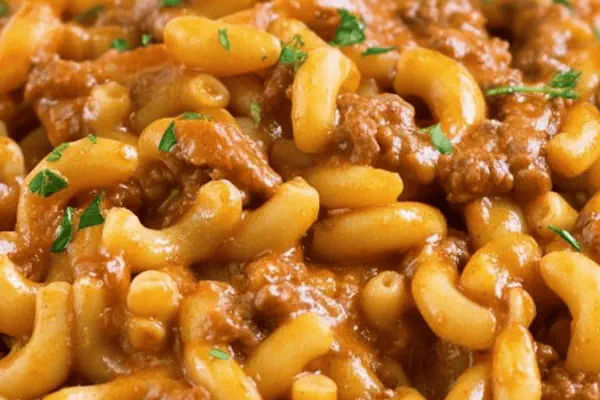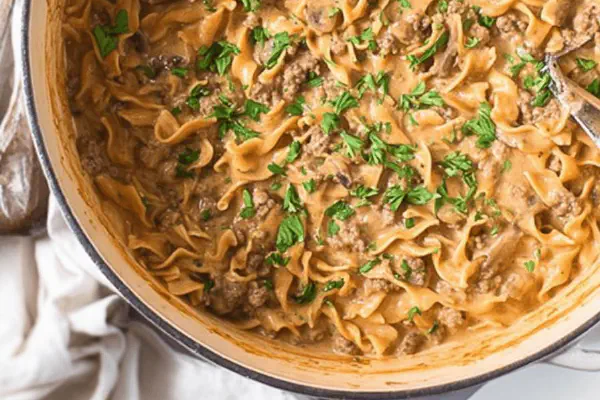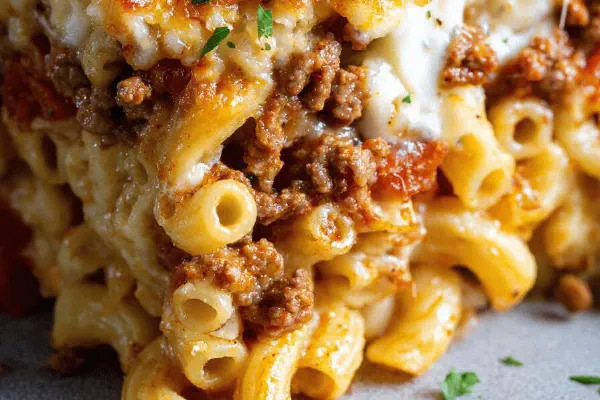Homemade Beef Pasta

By Emma
Certified Culinary Professional
Ingredients
- 1.5 pounds lean ground beef; substitute ground turkey or plant-based beef for twist
- 4 cloves garlic minced
- 4 cups low-sodium beef broth
- 1 cup chicken broth instead of water; helps layering
- 4 tablespoons tomato paste
- 2 teaspoons onion powder
- 2 tablespoons Worcestershire sauce
- 1 teaspoon smoked paprika; swap for regular paprika if needed
- 2 teaspoons dried parsley
- 1 teaspoon freshly ground black pepper
- 2 cups elbow macaroni
- 2 cups shredded sharp cheddar cheese; try Gouda for twist
- Salt to taste (optional)
About the ingredients
Method
- Heat large 5-quart pot over medium-high until just starting to smoke; toss in ground beef and minced garlic. Let sit few minutes before breaking apart, listen for sizzle shifts, smell garlic sweetening. Brown fully, no pink showing. Drain excess fat if more than tablespoon; lean beef won't weep much.
- Add beef broth and chicken broth to pot. Stir in tomato paste evenly, breaking up clumps to coat beef mixture in thick red layer. Sprinkle onion powder, Worcestershire, smoked paprika, parsley, and pepper. Heat stays medium-high; you want aggressive simmer to build flavor layers. Flames licking sides, liquid should almost scream boil.
- Once the mix roils in full boil – large bubbling aggressive boil popping – reduce heat to medium. Watch closely, don’t let calm fade.
- Add elbow macaroni all at once. Stir immediately to avoid mac sticking to pan bottom. Pasta will bulk and swell, grab a wooden spoon and keep it moving every 3 to 4 minutes – scrape the bottom and sides to prevent burning. The sauce thickens and darkens, a tell of starch release. After 22 to 28 minutes, poke a piece of pasta; it’s done when tender but firm to bite.
- Remove from heat. Gradually stir in cheddar in half-cup increments, watching goopy cheese melt into sauce, creates velvety hold. Cheese quantity adjustable; add less if you prefer less rich. Longer cheese mixing avoids clumps. Taste and season lightly with salt if needed depending on broth saltiness.
- Let rest 5 minutes off heat; sauce thickens further and flavors deepen. If reheating, add splash broth or water to loosen.
Cooking tips
Chef's notes
- 💡 Brown ground beef and garlic first. Listen for sizzle changes. Garlic aroma shifts from sharp to sweet—watch closely avoid burnt. Drain fat if more than tablespoon, else keep flavor tight. Browning sets deep foundation; skip this, sauce flattens.
- 💡 Stir tomato paste till clumps vanish. Coat beef fully. Paste thickens sauce, if missed clumps cause uneven flavor pockets. Use full tablespoons; watery sauce means skimpy paste. Heat kept at aggressive simmer makes difference. Flames licking pot sides tell you heat’s there.
- 💡 Watch the boil, not a timer. Pasta timing varies, poke noodle for firm bite, no crunch but not mush. Sauce thickens as starch releases, color darkens from ruby red to deeper tone means caramelizing flavors inside. Stir every few minutes; bottom burns quick otherwise.
- 💡 Add cheese gradually—half cup bits. Cheese melts slow and velvety; dumping all at once causes clumps or greasy blobs. Use sharp cheddar mostly but swap Gouda or Monterey Jack for milder creamy textures. Mix long to avoid grainy spots or stringy cheese lumps.
- 💡 Rest off heat for minimum five minutes. Sauce firms, flavors deep more than first stir. If reheating next day, always add broth or water splash to loosen sauce; cold thickens harshly. Stir gently, heat slowly—avoid tough sauce or dried out pasta pieces. You want pliable, not clumpy.
Common questions
Can I swap ground beef with turkey?
Yes but moisture changes. Turkey is leaner, less fat, so less flavor and lubrication. Might need little oil added. Cook garlic slower or powder to avoid dryness. Texture slightly different, softer bite. Watch fat discard less.
What if pasta sticks or clumps?
Stirring key. Immediately after addition and every few. Use wooden spoon, scrape bottom and sides. Sauce thickens via starch, it glues pasta if you leave it. If stuck, add splash broth or water, loosen gently. Avoid too much stirring or breakage.
How do I know pasta is done?
Poke noodle, firm-yet-tender texture. No crunch, no mush. Timing varies due to stove heat, pot size. Starch release darkens sauce, it thickens, bubbles get vigorous or slow—watch visual clues not clock. Overcooked pasta smells faintly burned.
Can leftovers be frozen or refrigerated?
Refrigerate fine for 3 to 4 days. Reheat with broth or water splash for sauce loosened. Freeze okay but cheese texture shifts, sauce may separate slightly. Defrost slow. Stir well when reheating. Avoid microwaving dry without liquid.



